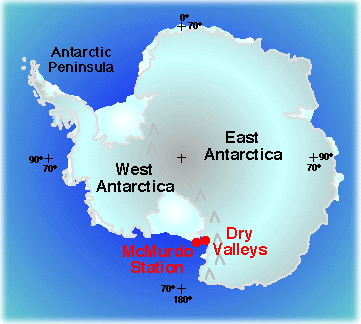
My name is Kevin "soon to be polar explorer" Lavigne. For the last
three years, I have been teaching at Hanover High School. The high school
is located in the picturesque New England town of Hanover, New Hampshire,
home of Dartmouth College. This year I am teaching Honors Chemistry,
Chemistry and Evolution and Genetics. I have also taught Biology and a
course called CAPPS (Chemistry and Physics Problems for Seniors). Before
teaching at Hanover High I taught in northern Vermont at Missisquoi Valley
Union High School. I graduated from the University of Vermont in 1991.
With the beginning of a new millennium, I received some fantastic news, I
was accepted into the TEA program and would soon be traveling to the polar
regions! While riding the energy high that followed, I reflected upon the
wondrous opportunities and adventures that teaching has allowed me to
experience.
Early in my teaching career, and the peak of the latest Dinosaur
craze sparked by the release of Jurassic Park, I became involved with
Dinamations International Society in Grand Junction, Colorado. For three
summers, I parcticipated in an ongoing excavation of the Mygatt-Moore site,
a Late Jurassic watering hole, working with Dr. James Kirkland, best known
for his discovery of a new genus of dromaeosaurid called Utahraptor.
During the summer of my third year, I took fourteen students out west with
me to "dig dinos".
The last three summers, my interest shifted to marine biology and
oceanography. Instead of packing up and traveling west, I explored the
possibilities closer to home in Woods Hole, Massachusetts. Located in
this small town are the Marine Biological Laboratory (MBL), Woods Hole
Oceanography Institute (WHOI), and the National Oceanic and Atmospheric
Administration (NOAA). I was volunteering in Dr. Roger Hanlon's cephalopod
lab located in the Marine Resource Center (MRC) of MBL. Working with Dr.
Nadav Shashar, I took on a project of my own design, the investigation of
polarized vision in the squid species Loligo pealei.
Now I am looking forward to the new possibilities presented by the
TEA experience and Antarctica. I will be working with Dr. Ross Virginia,
Environmental Studies Chair of Dartmouth College, and through this
connection and the proximity of the high school to the college, I hope to
involve the students in my polar experience.

McMurdo Dry Valleys - Long Term Ecological Research Project
Dr. Ross Virginia,Dartmouth College
My project is going to take me to the McMurdo Dry Valleys (MCM) where I will parcticipate in the Long Term Ecological Research (LTER) project that was established in an effort to document widespread changes in the world1s ecosystem. This project consists of 21 sites that "share a common commitment to create a legacy of well-designed and well-documented long term field experiments and observations for use by future generations to improve the understanding of basic properties of ecosystems as well as factors causing widespread changes in the world1s ecosystem" (for more information check out: http://www.nrel.colostate.edu/ soil/MCM.html and http://www.dartmouth.edu/~ravirg/RAV.research.html).
The McMurdo Dry Valleys (MCM) has been identified as one of the few places on this planet were the first effects of climate change should be observed. This is due to the fact that the MCM ecosystem is sensitive to very small variations in climate for two reasons. First, the change between solid and liquid phase of water is delicately poised in this extreme environment. Second, liquid water is the primary limiting condition for life in Antarctica.
The McMurdo Dry Valleys LTER project has successfully completed seven field
seasons (first field season was 1992-93), and since that time it has
developed into three major areas of research that serve as umbrellas for
several important legacies. The first major research area is hydrology.
Understanding the structure and function of the dry valley ecosystem
requires understanding hydrological responses to climate, both now and in
the past. The second area is biological activity and
diversity. Biological activity in the dry valley is directly related to the
past and present distribution of water, and is found when liquid water is
present and nutrient availability is adequate. Microbial mats and
phytoplankton are found in ephemeral streams and perennially ice-covered
lakes. Nematodes represent the top of the food chain in the coldest,
oldest and driest soils on Earth. The nematode community consists of an
endemic species, Scottnema lindsayae , a microbial feeder (bacteria
and yeast), Plectus antarcticus, a bacterial feeder, and
Eudorylaimus antarcticus, an omnivore-predator. While nematodes
are aquatic animals, they are uniquely suited for survival in this extreme
environment, since they can enter a survival state, anhydrobiosis, for
extended periods. Anhydrobiosis is a state in which the organism are
capable of prolonged survival with limiting moisture and temperatures below
freezing. Biogeochemical processes, is the last major area of research.
Here the research focuses on the mineralization of nutrients, and
geochemical weathering that occurs when liquid water is present.


